Montanavision, Inc.
Client since 1993.
In 1986, Bill Reier sold Bozeman radio stations KBOZ-AM+FM to Larry Wilson,
forming the foundation of Citadel Communications Corporation.

In 1991, Citadel purchased Livingston station KYBS-FM, making the combo
into a trombo. We started caring for their engineering needs in 1993.
1090 KBOZ-AM
Bill Reier put KBOZ on the air in December, 1975. The original format was
Top 40. Early on-air personalities included Paul Van Ellis and Dean
Alexander. The first Chief Engineer was Jack Nordquist. In 1980, the format
was changed to country, Steve Campbell became Chief Engineer,
and KBZN-FM was added to the operation. The KBOZ-AM transmitter and antenna
array have remained virtually unchanged since then.
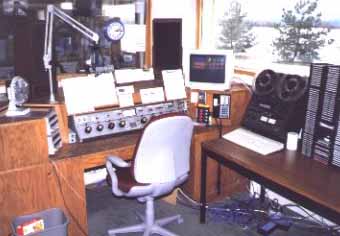
Though this studio has undergone many changes, the
original woodwork and the original console were in use until March, 2004.
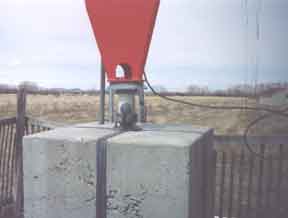
Detail of the base of Tower 4, showing that the upper ball
of the lightning gap is missing, 03-Apr-1999.

Midway obstruction light and fiberglass guy insulator at 125 foot
level on Tower 4, 03-Apr-1999.
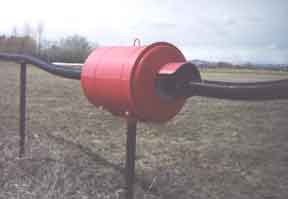
50 kW FM iso-coupler at the base of Tower 5, 03-Apr-1999.
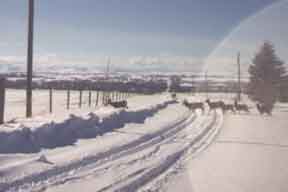
A small herd of deer cross the road near Monitor Point 3,
on the east end of Nash Road, 15-Feb-1999.
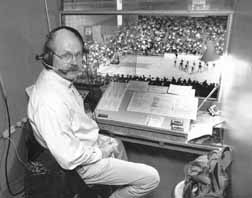
KBOZ was the flagship station for the Montana State
University-Bozeman Fighting Bobcats since the mid-1980s. Here
is the voice of the Fighting Bobcats, Dean Alexander, in the booth at
Worthington Arena, MSU-Bozeman, November, 1999.
93.7 Cat Country KATH-FM
Bozeman's first commercial FM station signed on in September, 1980, as KBZN-FM.
It operated on 93.7 MHz with 100,000 Watts from an antenna on the
KBOZ-AM array on Johnson Road. Within a few years, the transmitter
was moved to the Story Hill Site and the call sign was changed to KBOZ-FM.
Up until 1993, the format was generally Pop, Top 40, or Rock.
From 1993 to 1996, the call letters were
KATH-FM, and the format was hot country.

The Story Hill Electronic Site,
on the northeast edge of Bozeman,
was home to several high-power signals. The 93.7 MHz signal was
broadcast from the tall tower on the right. March, 1998.
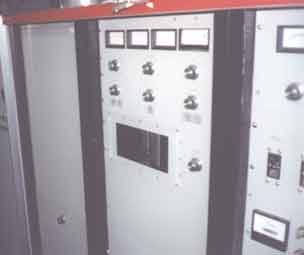
The Rockwell Collins 831G-3 transmitter for 93.7 MHz was originally
installed at the studio, southwest of Bozeman. The coverage of the
downtown area was so bad that it was moved to the Story Hill site
in 1981.
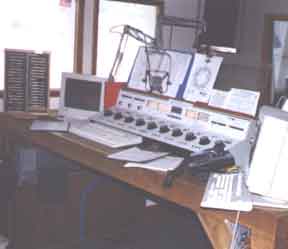
Control board and main counter in KATH studio, 09-Jan-1999.
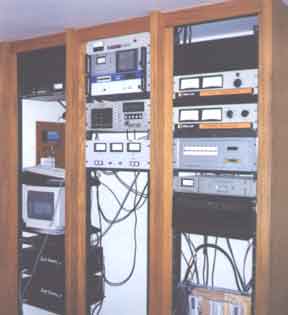
Steve Campbell's custom equipment racks in the rear of the
KATH-FM studio, 09-Jan-1999.
97.5 The Peak KPKX-FM
This station started life in 1985 as KYBS-FM, licensed to Livingston,
Montana. It became a Citadel station in 1991, when the call letters
were changed to KATH-FM. The old-time country format of KYBS-FM gave
way to Cat Country, a proprietary Citadel format. In 1993, Cat Country
moved to 93.7, and this station became KBOZ-FM, with a rock format.
In 1995, the call letters were changed to KPKX-FM, and the format
changed to alternative rock.
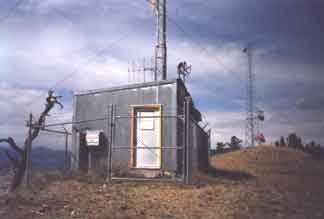
This building houses the 97.5 MHz transmitter on
Bozeman Pass, 01-Sep-1999.
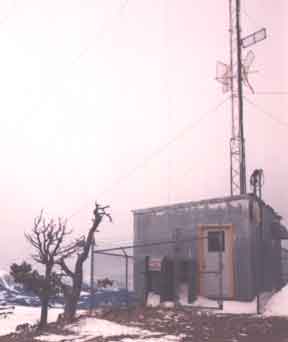
For a time, FCC Rules required the station to keep the main studio
in Livingston, and originate some programming from it. The STL dish
on the right received programming from Livingston, while the dish on the left
received programming from Bozeman. A remote-controlled switch inside
selected which studio was on the air. Jan 1994.
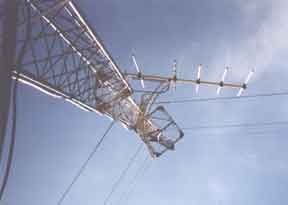
The Yagi antenna on the right is the backup antenna for low-power
operation, 21-May-1999.
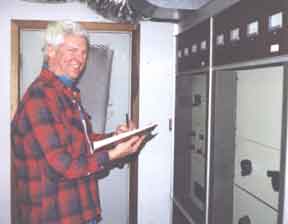
Jim logs the operating parameters of the McMartin BF-25M transmitter,
06-Jan-1999.
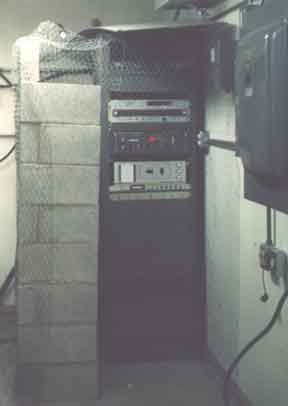
A previous engineer, in an attempt to reduce interference to the equipment
mounted in the rack, had this masonry wall built around it. When that did
not help, chicken wire was spread over it. As far as can be determined,
neither of those measures made any difference. In this 1994
photograph, the Continental 802B Exciter was still in operation at 97.5
MHz. In the late 90's, the original McMartin BFM-8000 exciter was returned to service.
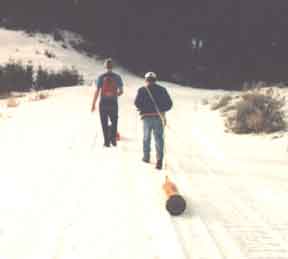
Honoring a time-hallowed tradition, Program Director Steve West hauls a
full nitrogen cylinder to the transmitter site, 16-Feb-1994.
Citadel Communications Corporation sold these stations
to Reier Broadcasting Company in 1996.
This page updated 14-Mar-2016.



























